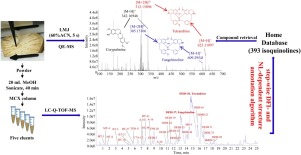当前位置:
X-MOL 学术
›
J. Pharmaceut. Biomed. Anal.
›
论文详情
Our official English website, www.x-mol.net, welcomes your
feedback! (Note: you will need to create a separate account there.)
Comprehensive profiling of Stephania tetrandra (Fangji) by stepwise DFI and NL-dependent structure annotation algorithm-based UHPLC-Q-TOF-MS and direct authentication by LMJ-HRMS.
Journal of Pharmaceutical and Biomedical Analysis ( IF 3.1 ) Pub Date : 2020-03-03 , DOI: 10.1016/j.jpba.2020.113225 Jinfeng Chen 1 , Qian Zhao 1 , Dandan Si 2 , Anzheng Nie 3 , Yuanyuan Wang 1 , Zhifen Deng 1 , Yibo Wen 1 , Fengmei Chen 1 , Lei Zhang 1 , Bowen Dong 1 , Jinghua Yang 1
Journal of Pharmaceutical and Biomedical Analysis ( IF 3.1 ) Pub Date : 2020-03-03 , DOI: 10.1016/j.jpba.2020.113225 Jinfeng Chen 1 , Qian Zhao 1 , Dandan Si 2 , Anzheng Nie 3 , Yuanyuan Wang 1 , Zhifen Deng 1 , Yibo Wen 1 , Fengmei Chen 1 , Lei Zhang 1 , Bowen Dong 1 , Jinghua Yang 1
Affiliation

|
Stephania tetrandra S. Moore, a widely used traditional antirheumatic herbal medicine (HM), is a rich source of isoquinoline alkaloids. With the exception of the two recognized isoquinolines, viz. tetrandrine and fangchinoline, the other isoquinoline alkaloids present in S. tetrandra have not been clearly clarified. In addition, due to their similar names and morphological similarities, S. tetrandra is often mistakenly substituted and adulterated with the nephrotoxic Aristolochia fangchi. In this study, ultra-high-performance liquid chromatography-triple time-of-flight mass spectrometry (UHPLC-Q-TOF-MS) was initially employed to comprehensively profile the isoquinolines from S. tetrandra. To overcome the complexities arising due to the similar mass behaviors of the isoquinolines, a stepwise diagnostic fragment ion (DFI) and neutral loss (NL)-dependent structure annotation algorithm was proposed, and this accelerated the identification of 393 isoquinolines distributed over twenty classes. Consequently, liquid microjunction surface sampling-high-resolution mass spectrometry (LMJ-HRMS) was deployed in an attempt to directly authenticate S. tetrandra by the chemical profiling of its crude slice. By matching the 393 isoquinolines, the 87 peaks detected by LMJ-HRMS were assigned to 270 isoquinolines, including the recognized tetrandrine and fangchinoline. The absence of aristolochic acid-related mass signals confirmed the authentication of S. tetrandra. In summary, LMJ-HRMS can be considered a direct, nondestructive, high-throughput, and environment-friendly analytical method for the authentication of HMs. Moreover, the stepwise DFI- and NL-dependent structure annotation algorithm-based UHPLC-Q-TOF-MS method allowed high-coverage detection and high-quality data processing of the inherent structural similarity and complexity of isoquinolines or other phytochemical compounds.
中文翻译:

通过基于DHPLC和依赖于NL的结构注释算法的基于UHPLC-Q-TOF-MS的逐步DFI和基于LMJ-HRMS的直接身份验证对Stephania tetrandra(Fangji)进行了全面的分析。
Stephania tetrandra S. Moore是一种广泛使用的传统抗风湿草药(HM),是异喹啉生物碱的丰富来源。除了两个公认的异喹啉,即。粉防己碱和防己诺林碱,丁香链霉菌中存在的其他异喹啉碱生物碱尚未明确阐明。此外,由于它们的相似名称和形态相似性,四倍体沙门氏菌经常被误认为是肾毒性马兜铃芳齿。在这项研究中,最初采用超高效液相色谱-三重飞行时间质谱(UHPLC-Q-TOF-MS)来全面鉴定沙门氏菌中的异喹啉。为了克服由于异喹啉的类似质量行为而引起的复杂性,提出了一种逐步诊断碎片离子(DFI)和中性损失(NL)依赖性的结构注释算法,该算法加快了对分布在二十个类别中的393个异喹啉的识别。因此,部署了液体微结表面采样-高分辨率质谱(LMJ-HRMS),以试图通过对其粗切片的化学谱分析来直接鉴定长春沙门氏菌。通过匹配393个异喹啉,将LMJ-HRMS检测到的87个峰分配给270个异喹啉,包括公认的粉防己碱和fangchinoline。不存在与马兜铃酸有关的质量信号证实了沙门氏菌的鉴定。总之,可以将LMJ-HRMS视为用于HM认证的直接,无损,高通量且环境友好的分析方法。此外,
更新日期:2020-03-03
中文翻译:

通过基于DHPLC和依赖于NL的结构注释算法的基于UHPLC-Q-TOF-MS的逐步DFI和基于LMJ-HRMS的直接身份验证对Stephania tetrandra(Fangji)进行了全面的分析。
Stephania tetrandra S. Moore是一种广泛使用的传统抗风湿草药(HM),是异喹啉生物碱的丰富来源。除了两个公认的异喹啉,即。粉防己碱和防己诺林碱,丁香链霉菌中存在的其他异喹啉碱生物碱尚未明确阐明。此外,由于它们的相似名称和形态相似性,四倍体沙门氏菌经常被误认为是肾毒性马兜铃芳齿。在这项研究中,最初采用超高效液相色谱-三重飞行时间质谱(UHPLC-Q-TOF-MS)来全面鉴定沙门氏菌中的异喹啉。为了克服由于异喹啉的类似质量行为而引起的复杂性,提出了一种逐步诊断碎片离子(DFI)和中性损失(NL)依赖性的结构注释算法,该算法加快了对分布在二十个类别中的393个异喹啉的识别。因此,部署了液体微结表面采样-高分辨率质谱(LMJ-HRMS),以试图通过对其粗切片的化学谱分析来直接鉴定长春沙门氏菌。通过匹配393个异喹啉,将LMJ-HRMS检测到的87个峰分配给270个异喹啉,包括公认的粉防己碱和fangchinoline。不存在与马兜铃酸有关的质量信号证实了沙门氏菌的鉴定。总之,可以将LMJ-HRMS视为用于HM认证的直接,无损,高通量且环境友好的分析方法。此外,











































 京公网安备 11010802027423号
京公网安备 11010802027423号